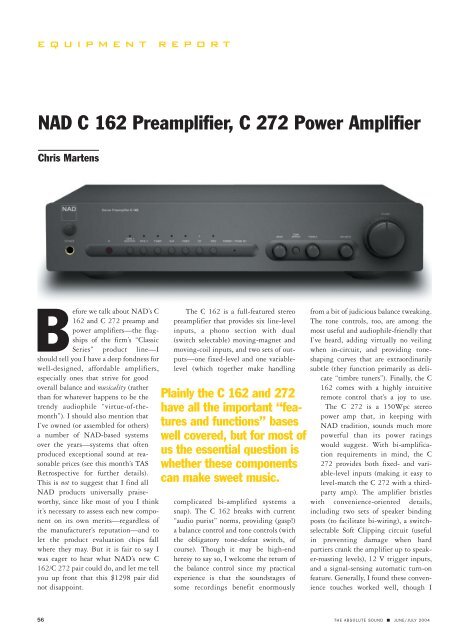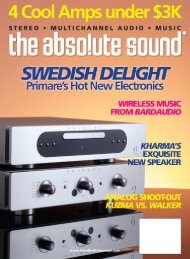Absolute Sound
Absolute Sound
Absolute Sound
You also want an ePaper? Increase the reach of your titles
YUMPU automatically turns print PDFs into web optimized ePapers that Google loves.
equipment report<br />
NAD C 162 Preamplifier, C 272 Power Amplifier<br />
Chris Martens<br />
Before we talk about NAD’s C<br />
162 and C 272 preamp and<br />
power amplifiers—the flagships<br />
of the firm’s “Classic<br />
Series” product line—I<br />
should tell you I have a deep fondness for<br />
well-designed, affordable amplifiers,<br />
especially ones that strive for good<br />
overall balance and musicality (rather<br />
than for whatever happens to be the<br />
trendy audiophile “virtue-of-themonth”).<br />
I should also mention that<br />
I’ve owned (or assembled for others)<br />
a number of NAD-based systems<br />
over the years—systems that often<br />
produced exceptional sound at reasonable<br />
prices (see this month’s TAS<br />
Retrospective for further details).<br />
This is not to suggest that I find all<br />
NAD products universally praiseworthy,<br />
since like most of you I think<br />
it’s necessary to assess each new component<br />
on its own merits—regardless of<br />
the manufacturer’s reputation—and to<br />
let the product evaluation chips fall<br />
where they may. But it is fair to say I<br />
was eager to hear what NAD’s new C<br />
162/C 272 pair could do, and let me tell<br />
you up front that this $1298 pair did<br />
not disappoint.<br />
The C 162 is a full-featured stereo<br />
preamplifier that provides six line-level<br />
inputs, a phono section with dual<br />
(switch selectable) moving-magnet and<br />
moving-coil inputs, and two sets of outputs—one<br />
fixed-level and one variablelevel<br />
(which together make handling<br />
Plainly the C 162 and 272<br />
have all the important “features<br />
and functions” bases<br />
well covered, but for most of<br />
us the essential question is<br />
whether these components<br />
can make sweet music.<br />
complicated bi-amplified systems a<br />
snap). The C 162 breaks with current<br />
“audio purist” norms, providing (gasp!)<br />
a balance control and tone controls (with<br />
the obligatory tone-defeat switch, of<br />
course). Though it may be high-end<br />
heresy to say so, I welcome the return of<br />
the balance control since my practical<br />
experience is that the soundstages of<br />
some recordings benefit enormously<br />
from a bit of judicious balance tweaking.<br />
The tone controls, too, are among the<br />
most useful and audiophile-friendly that<br />
I’ve heard, adding virtually no veiling<br />
when in-circuit, and providing toneshaping<br />
curves that are extraordinarily<br />
subtle (they function primarily as delicate<br />
“timbre tuners”). Finally, the C<br />
162 comes with a highly intuitive<br />
remote control that’s a joy to use.<br />
The C 272 is a 150Wpc stereo<br />
power amp that, in keeping with<br />
NAD tradition, sounds much more<br />
powerful than its power ratings<br />
would suggest. With bi-amplification<br />
requirements in mind, the C<br />
272 provides both fixed- and variable-level<br />
inputs (making it easy to<br />
level-match the C 272 with a thirdparty<br />
amp). The amplifier bristles<br />
with convenience-oriented details,<br />
including two sets of speaker binding<br />
posts (to facilitate bi-wiring), a switchselectable<br />
Soft Clipping circuit (useful<br />
in preventing damage when hard<br />
partiers crank the amplifier up to speaker-roasting<br />
levels), 12 V trigger inputs,<br />
and a signal-sensing automatic turn-on<br />
feature. Generally, I found these convenience<br />
touches worked well, though I<br />
56 THE ABSOLUTE SOUND ■ JUNE/JULY 2004










